transmission CHEVROLET COLORADO 2007 1.G Owners Manual
[x] Cancel search | Manufacturer: CHEVROLET, Model Year: 2007, Model line: COLORADO, Model: CHEVROLET COLORADO 2007 1.GPages: 496, PDF Size: 2.7 MB
Page 99 of 496
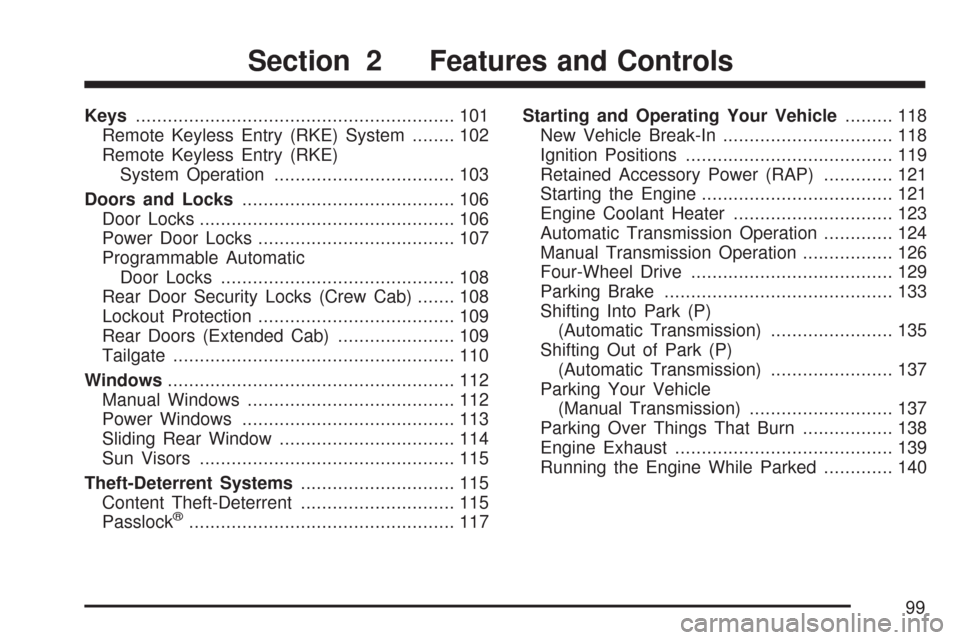
Keys............................................................ 101
Remote Keyless Entry (RKE) System........ 102
Remote Keyless Entry (RKE)
System Operation.................................. 103
Doors and Locks........................................ 106
Door Locks................................................ 106
Power Door Locks..................................... 107
Programmable Automatic
Door Locks............................................ 108
Rear Door Security Locks (Crew Cab)....... 108
Lockout Protection..................................... 109
Rear Doors (Extended Cab)...................... 109
Tailgate..................................................... 110
Windows...................................................... 112
Manual Windows....................................... 112
Power Windows........................................ 113
Sliding Rear Window................................. 114
Sun Visors................................................ 115
Theft-Deterrent Systems............................. 115
Content Theft-Deterrent............................. 115
Passlock
®.................................................. 117Starting and Operating Your Vehicle......... 118
New Vehicle Break-In................................ 118
Ignition Positions....................................... 119
Retained Accessory Power (RAP)............. 121
Starting the Engine.................................... 121
Engine Coolant Heater.............................. 123
Automatic Transmission Operation............. 124
Manual Transmission Operation................. 126
Four-Wheel Drive...................................... 129
Parking Brake........................................... 133
Shifting Into Park (P)
(Automatic Transmission)....................... 135
Shifting Out of Park (P)
(Automatic Transmission)....................... 137
Parking Your Vehicle
(Manual Transmission)........................... 137
Parking Over Things That Burn................. 138
Engine Exhaust......................................... 139
Running the Engine While Parked............. 140
Section 2 Features and Controls
99
Page 108 of 496
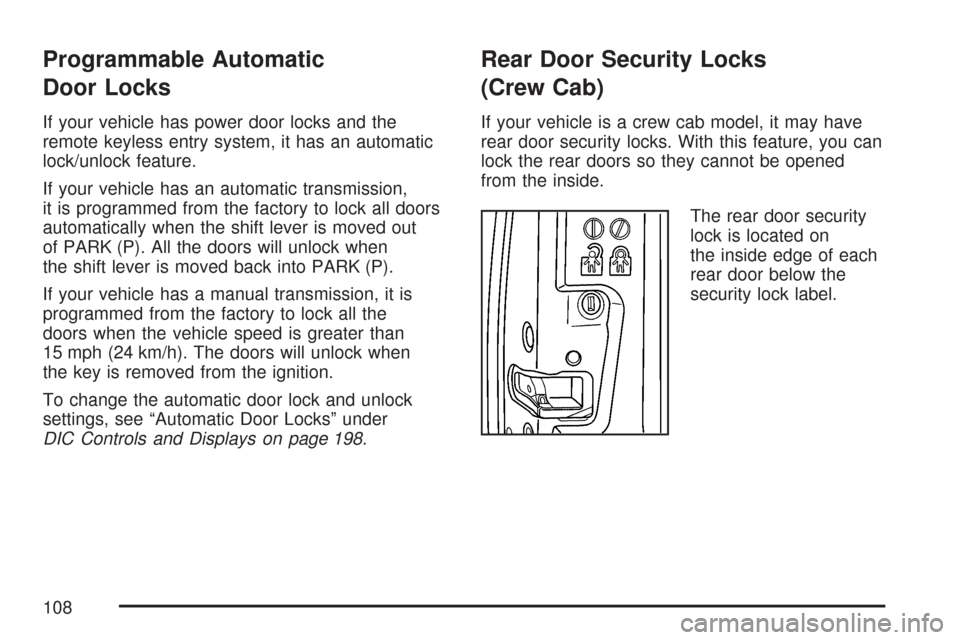
Programmable Automatic
Door Locks
If your vehicle has power door locks and the
remote keyless entry system, it has an automatic
lock/unlock feature.
If your vehicle has an automatic transmission,
it is programmed from the factory to lock all doors
automatically when the shift lever is moved out
of PARK (P). All the doors will unlock when
the shift lever is moved back into PARK (P).
If your vehicle has a manual transmission, it is
programmed from the factory to lock all the
doors when the vehicle speed is greater than
15 mph (24 km/h). The doors will unlock when
the key is removed from the ignition.
To change the automatic door lock and unlock
settings, see “Automatic Door Locks” under
DIC Controls and Displays on page 198.
Rear Door Security Locks
(Crew Cab)
If your vehicle is a crew cab model, it may have
rear door security locks. With this feature, you can
lock the rear doors so they cannot be opened
from the inside.
The rear door security
lock is located on
the inside edge of each
rear door below the
security lock label.
108
Page 119 of 496
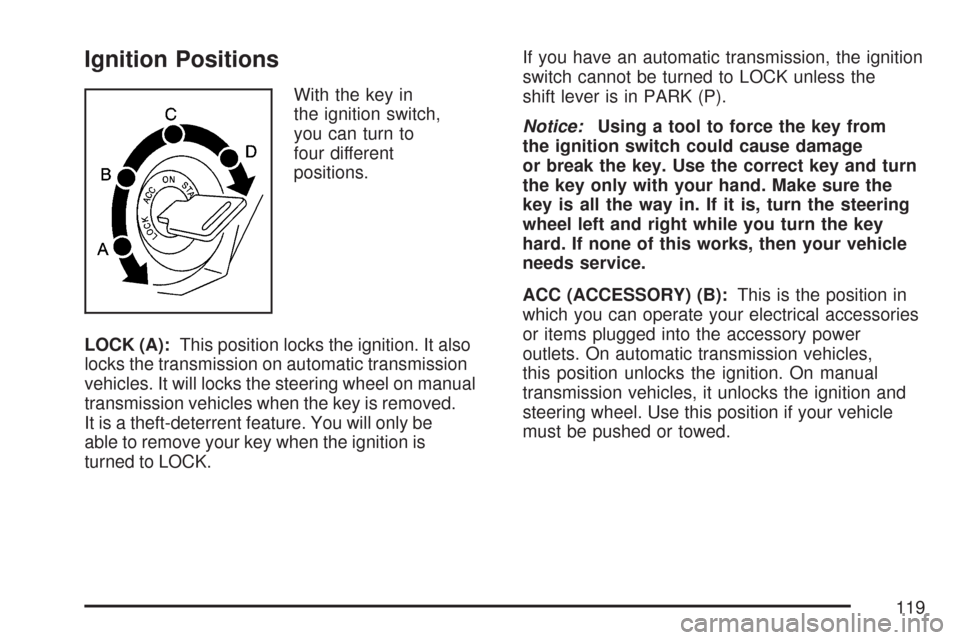
Ignition Positions
With the key in
the ignition switch,
you can turn to
four different
positions.
LOCK (A):This position locks the ignition. It also
locks the transmission on automatic transmission
vehicles. It will locks the steering wheel on manual
transmission vehicles when the key is removed.
It is a theft-deterrent feature. You will only be
able to remove your key when the ignition is
turned to LOCK.If you have an automatic transmission, the ignition
switch cannot be turned to LOCK unless the
shift lever is in PARK (P).
Notice:Using a tool to force the key from
the ignition switch could cause damage
or break the key. Use the correct key and turn
the key only with your hand. Make sure the
key is all the way in. If it is, turn the steering
wheel left and right while you turn the key
hard. If none of this works, then your vehicle
needs service.
ACC (ACCESSORY) (B):This is the position in
which you can operate your electrical accessories
or items plugged into the accessory power
outlets. On automatic transmission vehicles,
this position unlocks the ignition. On manual
transmission vehicles, it unlocks the ignition and
steering wheel. Use this position if your vehicle
must be pushed or towed.
119
Page 120 of 496

ON (C):This is the position that the switch
returns to after you start your engine and release
the switch. The switch stays in ON when the
engine is running. But even when the engine is
not running, you can use ON to operate the
electrical accessories and to display some
instrument panel cluster warning and indicator
lights. The transmission is also unlocked in
this position on automatic transmission vehicles.
The battery could be drained if you leave the key in
the ACC or ON position with the engine off. You
may not be able to start your vehicle if the battery is
allowed to drain for an extended period of time.
START (D):This is the position that starts the
engine. When the engine starts, release the key.
The ignition switch returns to ON for driving.
When the engine is not running, ACC and ON
allows you to operate the electrical accessories,
such as the radio or items plugged into the
accessory power outlets.A warning tone will sound if you open the driver’s
door when the ignition is in ACC or LOCK and
the key is in the ignition.
Key In the Ignition
Never leave your vehicle with the keys inside, as it
is an easy target for joy riders or thieves. If you
leave the key in the ignition and park your vehicle,
a chime will sound, when you open the driver’s
door. Always remember to remove your key from
the ignition and take it with you. This will lock
your ignition and transmission. Also, always
remember to lock the doors.
The battery could be drained if you leave the
key in the ignition while your vehicle is parked.
You may not be able to start your vehicle after
it has been parked for an extended period
of time.
120
Page 121 of 496
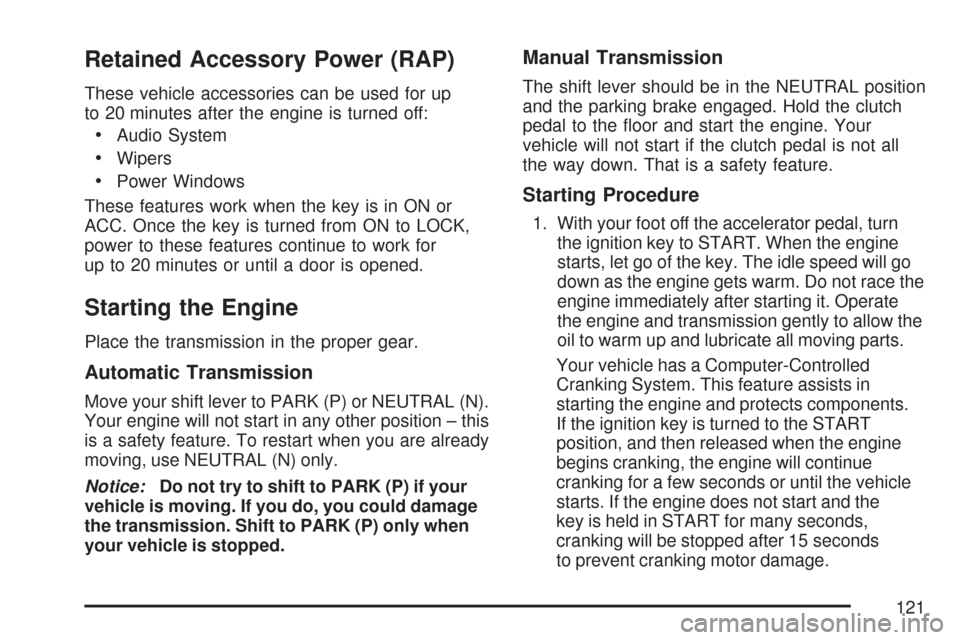
Retained Accessory Power (RAP)
These vehicle accessories can be used for up
to 20 minutes after the engine is turned off:
Audio System
Wipers
Power Windows
These features work when the key is in ON or
ACC. Once the key is turned from ON to LOCK,
power to these features continue to work for
up to 20 minutes or until a door is opened.
Starting the Engine
Place the transmission in the proper gear.
Automatic Transmission
Move your shift lever to PARK (P) or NEUTRAL (N).
Your engine will not start in any other position – this
is a safety feature. To restart when you are already
moving, use NEUTRAL (N) only.
Notice:Do not try to shift to PARK (P) if your
vehicle is moving. If you do, you could damage
the transmission. Shift to PARK (P) only when
your vehicle is stopped.
Manual Transmission
The shift lever should be in the NEUTRAL position
and the parking brake engaged. Hold the clutch
pedal to the �oor and start the engine. Your
vehicle will not start if the clutch pedal is not all
the way down. That is a safety feature.
Starting Procedure
1. With your foot off the accelerator pedal, turn
the ignition key to START. When the engine
starts, let go of the key. The idle speed will go
down as the engine gets warm. Do not race the
engine immediately after starting it. Operate
the engine and transmission gently to allow the
oil to warm up and lubricate all moving parts.
Your vehicle has a Computer-Controlled
Cranking System. This feature assists in
starting the engine and protects components.
If the ignition key is turned to the START
position, and then released when the engine
begins cranking, the engine will continue
cranking for a few seconds or until the vehicle
starts. If the engine does not start and the
key is held in START for many seconds,
cranking will be stopped after 15 seconds
to prevent cranking motor damage.
121
Page 122 of 496
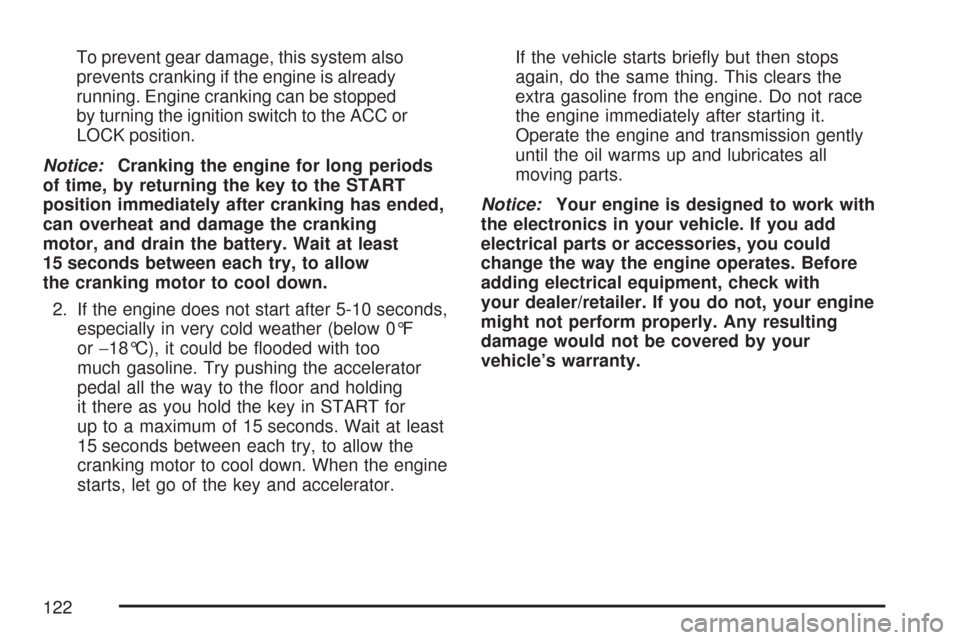
To prevent gear damage, this system also
prevents cranking if the engine is already
running. Engine cranking can be stopped
by turning the ignition switch to the ACC or
LOCK position.
Notice:Cranking the engine for long periods
of time, by returning the key to the START
position immediately after cranking has ended,
can overheat and damage the cranking
motor, and drain the battery. Wait at least
15 seconds between each try, to allow
the cranking motor to cool down.
2. If the engine does not start after 5-10 seconds,
especially in very cold weather (below 0°F
or−18°C), it could be �ooded with too
much gasoline. Try pushing the accelerator
pedal all the way to the �oor and holding
it there as you hold the key in START for
up to a maximum of 15 seconds. Wait at least
15 seconds between each try, to allow the
cranking motor to cool down. When the engine
starts, let go of the key and accelerator.If the vehicle starts brie�y but then stops
again, do the same thing. This clears the
extra gasoline from the engine. Do not race
the engine immediately after starting it.
Operate the engine and transmission gently
until the oil warms up and lubricates all
moving parts.
Notice:Your engine is designed to work with
the electronics in your vehicle. If you add
electrical parts or accessories, you could
change the way the engine operates. Before
adding electrical equipment, check with
your dealer/retailer. If you do not, your engine
might not perform properly. Any resulting
damage would not be covered by your
vehicle’s warranty.
122
Page 124 of 496
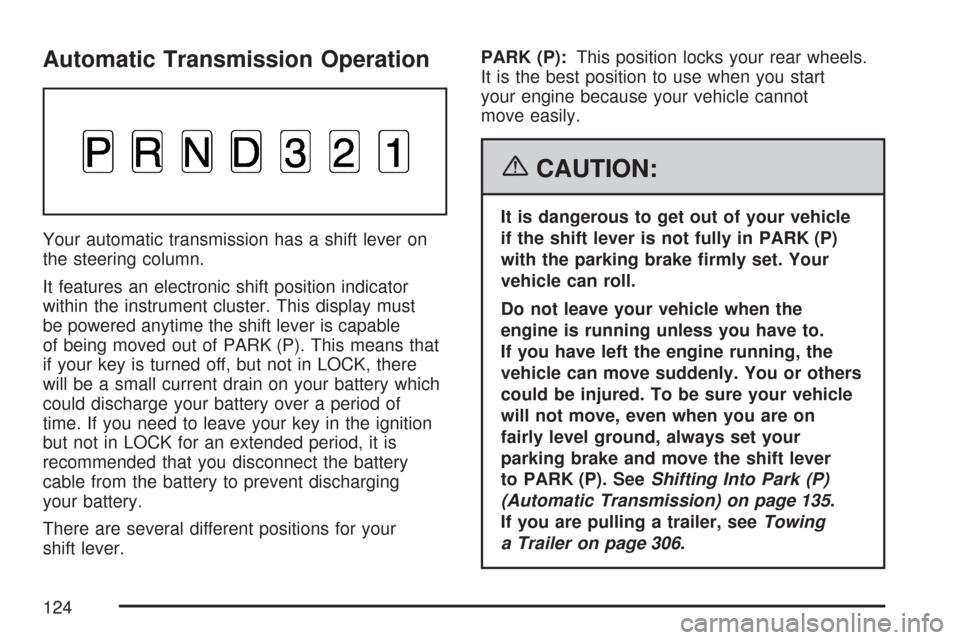
Automatic Transmission Operation
Your automatic transmission has a shift lever on
the steering column.
It features an electronic shift position indicator
within the instrument cluster. This display must
be powered anytime the shift lever is capable
of being moved out of PARK (P). This means that
if your key is turned off, but not in LOCK, there
will be a small current drain on your battery which
could discharge your battery over a period of
time. If you need to leave your key in the ignition
but not in LOCK for an extended period, it is
recommended that you disconnect the battery
cable from the battery to prevent discharging
your battery.
There are several different positions for your
shift lever.PARK (P):This position locks your rear wheels.
It is the best position to use when you start
your engine because your vehicle cannot
move easily.
{CAUTION:
It is dangerous to get out of your vehicle
if the shift lever is not fully in PARK (P)
with the parking brake �rmly set. Your
vehicle can roll.
Do not leave your vehicle when the
engine is running unless you have to.
If you have left the engine running, the
vehicle can move suddenly. You or others
could be injured. To be sure your vehicle
will not move, even when you are on
fairly level ground, always set your
parking brake and move the shift lever
to PARK (P). SeeShifting Into Park (P)
(Automatic Transmission) on page 135.
If you are pulling a trailer, seeTowing
a Trailer on page 306.
124
Page 125 of 496

Make sure the shift lever is fully in PARK (P)
before starting the engine. Your vehicle has an
automatic transmission shift lock control system.
You must fully apply your regular brakes before
you can shift from PARK (P) when the ignition
key is in ON. If you cannot shift out of PARK (P),
ease pressure on the shift lever by pushing
the shift lever all the way into PARK (P) as
you maintain brake application. Then move the
shift lever into another gear. SeeShifting Out
of Park (P) (Automatic Transmission) on page 137.
REVERSE (R):Use this gear to back up.
Notice:Shifting to REVERSE (R) while your
vehicle is moving forward could damage the
transmission. The repairs would not be covered
by your warranty. Shift to REVERSE (R) only
after your vehicle is stopped.
To rock your vehicle back and forth to get out
of snow, ice, or sand without damaging your
transmission, seeIf Your Vehicle is Stuck in Sand,
Mud, Ice, or Snow on page 290.NEUTRAL (N):In this position, your engine does
not connect with the wheels. To restart when
you are already moving, use NEUTRAL (N) only.
{CAUTION:
Shifting into a drive gear while your
engine is running at high speed is
dangerous. Unless your foot is �rmly on
the brake pedal, your vehicle could move
very rapidly. You could lose control and
hit people or objects. Do not shift into a
drive gear while your engine is running
at high speed.
Notice:Shifting out of PARK (P) or
NEUTRAL (N) with the engine running at
high speed may damage the transmission.
The repairs would not be covered by your
warranty. Be sure the engine is not running
at high speed when shifting your vehicle.
125
Page 126 of 496

DRIVE (D):This position is for normal driving.
If provides the best fuel economy for your vehicle.
If you need more power for passing, and you are:
Going less than about 35 mph (55 km/h), push
your accelerator pedal about halfway down.
Going about 35 mph (55 km/h) or more, push
the accelerator all the way down.
You will shift down to the next gear and have
more power.
Downshifting the transmission in slippery road
conditions could result in skidding, see “Skidding”
underLoss of Control on page 259.
THIRD (3):This position is also used for normal
driving. However, it reduces vehicle speed
more than DRIVE (D) without using your brakes.
You might choose THIRD (3) instead of DRIVE (D)
when driving on hilly, winding roads, when
towing a trailer, so there is less shifting between
gears and when going down a steep hill.
SECOND (2):This position reduces vehicle speed
even more than THIRD (3) without using your
brakes. You can use SECOND (2) on hills. It can
help control your speed as you go down steep
mountain roads, but then you would also want to
use your brakes off and on.FIRST (1):This position reduces vehicle speed
even more than SECOND (2) without using
your brakes. You can use it on very steep hills, or
in deep snow or mud. If the shift lever is put in
FIRST (1) while the vehicle is moving forward, the
transmission will not shift into �rst gear until the
vehicle is going slowly enough.
Notice:Spinning the tires or holding the
vehicle in one place on a hill using only
the accelerator pedal may damage the
transmission. The repair will not be covered by
your warranty. If you are stuck, do not spin
the tires. When stopping on a hill, use the
brakes to hold the vehicle in place.
Manual Transmission Operation
This is your
shift pattern.
126
Page 127 of 496
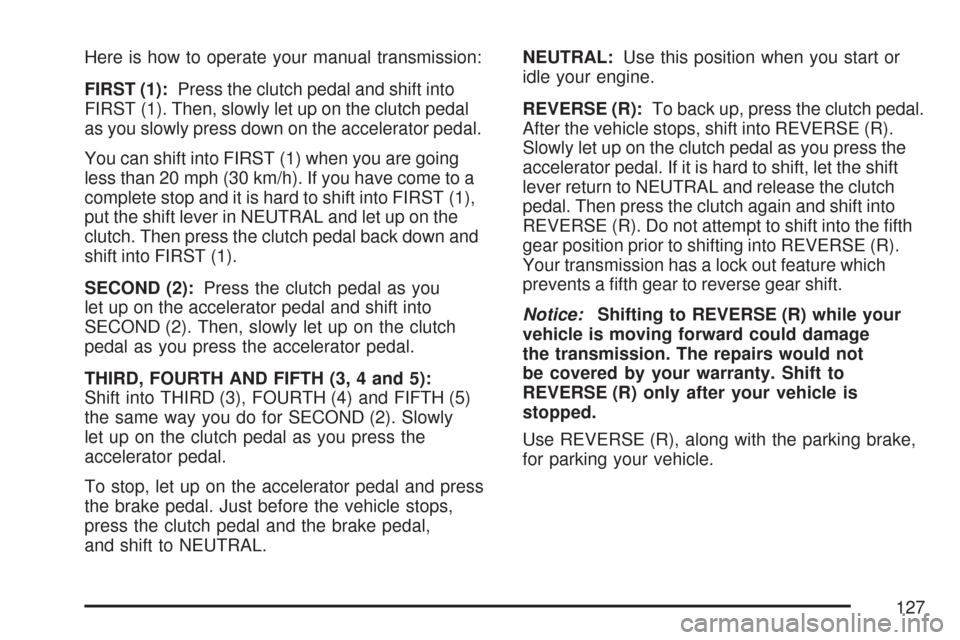
Here is how to operate your manual transmission:
FIRST (1):Press the clutch pedal and shift into
FIRST (1). Then, slowly let up on the clutch pedal
as you slowly press down on the accelerator pedal.
You can shift into FIRST (1) when you are going
less than 20 mph (30 km/h). If you have come to a
complete stop and it is hard to shift into FIRST (1),
put the shift lever in NEUTRAL and let up on the
clutch. Then press the clutch pedal back down and
shift into FIRST (1).
SECOND (2):Press the clutch pedal as you
let up on the accelerator pedal and shift into
SECOND (2). Then, slowly let up on the clutch
pedal as you press the accelerator pedal.
THIRD, FOURTH AND FIFTH (3, 4 and 5):
Shift into THIRD (3), FOURTH (4) and FIFTH (5)
the same way you do for SECOND (2). Slowly
let up on the clutch pedal as you press the
accelerator pedal.
To stop, let up on the accelerator pedal and press
the brake pedal. Just before the vehicle stops,
press the clutch pedal and the brake pedal,
and shift to NEUTRAL.NEUTRAL:Use this position when you start or
idle your engine.
REVERSE (R):To back up, press the clutch pedal.
After the vehicle stops, shift into REVERSE (R).
Slowly let up on the clutch pedal as you press the
accelerator pedal. If it is hard to shift, let the shift
lever return to NEUTRAL and release the clutch
pedal. Then press the clutch again and shift into
REVERSE (R). Do not attempt to shift into the �fth
gear position prior to shifting into REVERSE (R).
Your transmission has a lock out feature which
prevents a �fth gear to reverse gear shift.
Notice:Shifting to REVERSE (R) while your
vehicle is moving forward could damage
the transmission. The repairs would not
be covered by your warranty. Shift to
REVERSE (R) only after your vehicle is
stopped.
Use REVERSE (R), along with the parking brake,
for parking your vehicle.
127